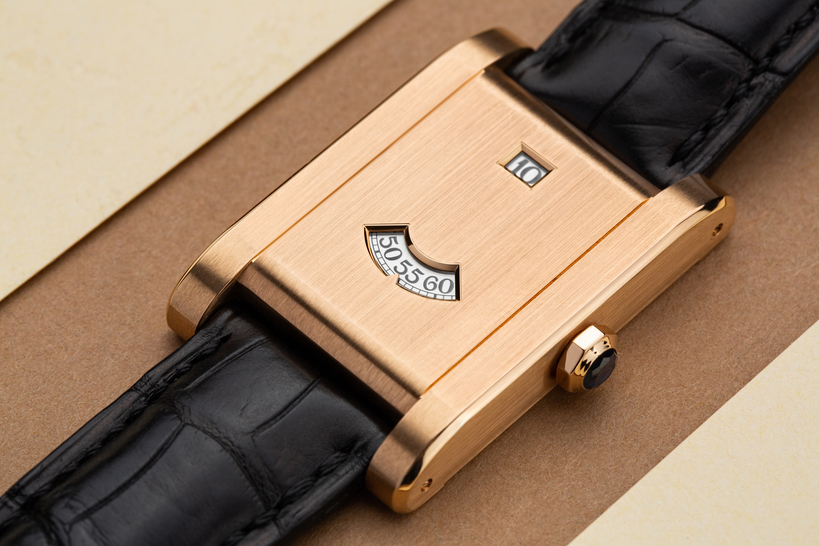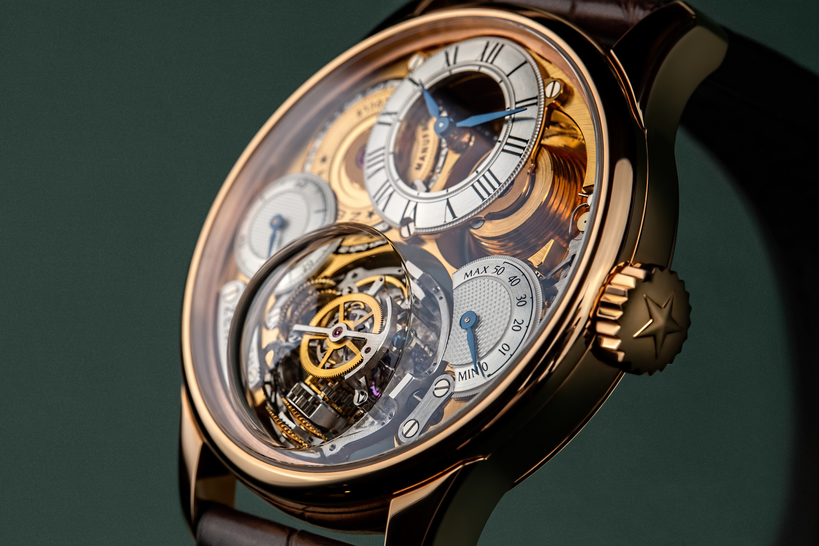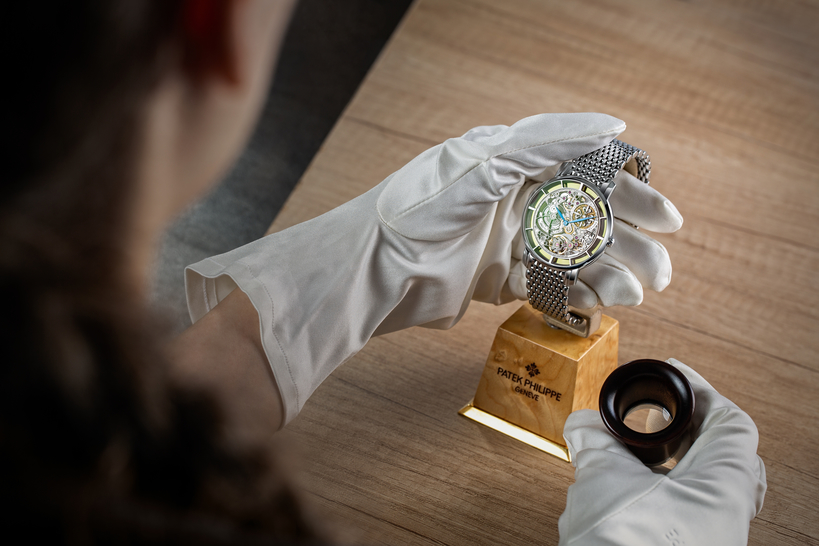Voutilainen modified vintage LeCoultre and Victorin Piguet ébauches for his Masterpiece series.
Voutilainen transformed the striking mechanism to chime in ten-minute intervals and added extra functions. To name a few, the Masterpiece 6 was given a power reserve indicator and the Masterpiece 7 Decimal Minute Repeater received a 24-hour indicator for a second time zone. Its design set the tone for the collection's subsequent models with the same function.
Voutilainen made an unexpected move in 2006 when he introduced the Chronograph Masterpiece. It was the first wristwatch to house a movement developed by the watchmaker himself. Independent watchmakers generally don't have the necessary funds at their disposal to develop a decent chronograph movement, so they it's a challenge they rarely take on.
Developing a chronograph usually doesn't show a decent return on investment, as the traditional chronograph is no less technically challenging in terms of its construction than a perpetual calendar, and it's even more technical than a tourbillon, yet the perception people tend to have is that a chronograph should be cheaper than the watches with other complications.
This doesn't apply as much to pieces made by independent watchmakers, who can offer unique pieces which gives them more freedom to set their own prices as they see fit. All the same, chronographs are still problematic. By the looks of things, Voutilainen took a calculated risk when he brought his unique Caliber 25Q to market.
The classic construction with a lateral clutch, column wheel and two pushers to activate the chronograph was paired with a mould-breaking balance and hairspring (chronographs with one pusher are yet to have their day). The quartz balance was equipped with gold poising cams and works with a carbon-composite balance spring.
Voutilainen teamed up with Gideon Levingston again for this innovation, who had the idea patented when he filed the application for his Carbontime patent back in 2002, but what's much more important is the fact that he developed the technology to manufacture these kinds of balance springs.
By the looks of things, Voutilainen took a calculated risk when he brought his unique Caliber 25Q to market.
The balance doesn't just boast progressive technical specs, with anti-magnetic properties and heat and cold adjustment within a wide range. Its transparency also gives the movement an extravagant look, which contrasts nicely with the traditional finishing used on its components, including frosted finish on the guilt bottom plate and bridges, and polished bevels with the numerous internal corners given the proper finishing.
It showcases plenty more signs of Voutilainen's mastery of traditional watchmaking skills. Voutilainen came up against every difficulty imaginable in the process of developing his own movement, as he made the transmission to equipping his watches with movements made entirely in-house.
This would have been impossible without modern metalworking technologies, and Voutilainen bought the first CNC milling machine for his workshop in 2007. When it came to the watches, he found a temporary yet no less impressive solution.
He looked to movements used in wristwatches manufactured from the 1940s through to the 1960s by the top Swiss factories, which were designed to compete in the chronometer competitions at the astronomical observatories.
These movements boasted superior technical specifications, but many of them weren't even destined to be housed in watches at the time when they were manufactured — they were too good to be put in ordinary serially produced watches. Voutilainen managed to get hold of a few dozen Peseux 260 chronometer movements.
They were released from 1945 through to 1970, and only about 3300 pieces were made. He used these movements as base calibers for his Observatoire watches. These ébauches only had hour, minute and small second hands. The chronological name for this highly modified movement for these watches would be Caliber 26.
The Observatoire watches debuted at Baselworld in spring 2007, and the watchmaker had already won the Men's Watch Prize and his first prize at the Grand Prix d’Horlogerie de Genève (GPHG) by fall. He now has eight GPHG prizes under his belt — an outstanding achievement for an independent watchmaker.
Voutilainen came up with the idea of using the Peseux 260 when one of his clients wanted to order a perpetual calendar watch. He considered these movements when looking into possible options to use as ébauches, and the idea later came to him to use them as a base to create a classic watch with just three hands.
The Observatoire watches debuted in spring 2007 and won the Men's Watch Prize at the Grand Prix d'Horlogerie de Genève (GPHG) by fall.
The Peseux 260 can be described as a purely practical and technical time-only movement without any frills. But Voutilainen worked his magic and gave it a top-notch thorough finishing, transforming the ébauche into a prime example of haute horlogerie.
The watchmaker later turned to another outstanding chronometer movement — the Longines caliber 360. The first series of them was produced in 1959 and the last was made in 1963, with only about 200 pieces ever made. Voutilainen managed to get hold of a batch of these ébauches and used them as a base to create the Chronomètre 27 in 2008, producing a limited edition of 25 white-gold pieces.
Like the Peseux 260, the Longines ébauche was given a fine and thorough finishing, with the hour and minute hand on separate axes (Longines wanted to ensure maximum accuracy for chronometer competitions back when the company made the ébauches).
Voutilainen's chronologically named Caliber 27 was given watch dial with a regulator layout. At the same time when Voutilainen was working on launching models with vintage ébauches, including manufacturing one-of-a-kind complicated Observatoire pieces, his workshop was working full steam ahead to assemble the watchmaker's own in-house movement to use as a base in 2008.
The new Caliber 28 was finally unveiled to the public in 2011. The Vingt-8 watch ("twenty-8" in French, a reference to the name of the movement) didn't look wildly different from the Observatoire watches, unless you consider the individual details of how each specific watch was made: the choice of metal, dial color or type of guilloché used.
The new movement was the biggest difference. Voutilainen developed his two-wheel direct impulse escapement for it based on Breguet's natural escapement, which doesn't need any lubrication to function (Fr. "échappement naturel", invented by Abraham-Louis Breguet in 1789).
The balance is massive for a wristwatch, which gives the movement a unique and remarkably beautiful appearance. It measures 13.6 mm in diameter, whereas the entire movement is only 30 mm in diameter.
The balance is made from stainless steel and furnished with gold poising cams similar to the ones used in the earlier Caliber 25Q encased in the Chronograph Masterpiece watches.
Voutilainen tested Breguet's natural escapement with the two balance wheels adapted for wristwatches and found that the construction was more efficient, which used about 30% less energy compared to the typical Swiss lever escapement, i.e. the industry standard. This of course equates to a greater power reserve, and the Caliber 28 provides 65 hours.
. The new Caliber 28 was finally unveiled to the public in 2011.
Almost all of Voutilainen's watches are now equipped with the Caliber 28 or one of its complicated versions, such as the GMT indicator for a second time zone (the Vingt-8 GMT-6 watch series manufactured since 2011), indicators for the power reserve (the V-8R watch series from 2013), as well as the combined GMT function with a power reserve indicator (the Vingt-8 GMT series from 2015).
When Voutilainen was constructing the main plate for the Caliber 28, he had the foresight to leave space which could be used to add extra functions in the future. This has given the collection based on this movement an impressive amount of versatility. The first of these was the Vingt-8 GMT-6 with a time zone indicator at 6 o'clock.
The impetus to create the watch came from a client who wanted to order a watch equipped with a decorative indicator for a second time zone like the ones seen on earlier Masterpiece 7 and Observatoire Day/Night models, but without the hands which ultimately necessitate case expansion.
Voutilainen removed the hand and replaced it with a decorative rotating disk for the indicator. It's worth noting that the watchmaker didn't rule out the option of putting a hand on this indicator. It made a reappearance on the one-of-a-kind Vingt-8 Zodiac GMT piece in 2013, ordered by a client with different taste.
The time zone on the Vingt-8 GMT-6 is set by pressing a co-axial pusher in the crown, which advances the second time-zone disk in hour increments. In 2012, Voutilainen introduced a new watch based on the same Caliber 28 movement. Its case was 2 mm smaller than that of the Vingt-8 at 37 mm in diameter, and it was also slimmed down from 11.5 mm to 9.5 mm.
The watch was meant to appeal to ladies, hence why the watchmaker chose to reverse the watch's name for the opposite sex to 2-Eight (another reinterpretation of the symbolic number 28). The functionality was reduced to two hands and the dial was decorated with mother of pearl.
Other than that, the watch remained true to its master's style, without any compromises on its construction and fine finishing. The year 2012 was also the year when the tourbillon movement's long story reached its closing chapter — a watch which the watchmaker had started working on back in 1996 and had been planning on keeping for himself.
He could never find enough time for himself though, as is often the case. The movement was scooped up by a client from New Zealand in the end, who managed to talk Voutilainen into seeing the project through and selling him the finished piece. The Tourbillon Détente Escapement is a pièce unique by Voutilainen, with a tourbillon which can be viewed through the sapphire crystal caseback, and it's also the watchmaker's only chronograph tourbillon.
The Masterpiece Chronograph II is the second edition of the Masterpiece Chronograph with a complicated version of the Caliber 25Q, which also came into being thanks to a client's commission. He received an order from six Californian watch collectors who were looking to purchase chronographs in 2010.
After three years spent developing the watch ordered by the group, the movement was given a big date and moon-phase displays, so the watch can be viewed as an extravagant realization of the idea to create a chronograph with an big date and off-centered subdials, i.e. an alternative to the Lange 1 Chronograph which never came into being. A total of ten Masterpiece Chronograph II watches were released: five white-gold pieces, two in pink gold, and one stainless steel piece.













